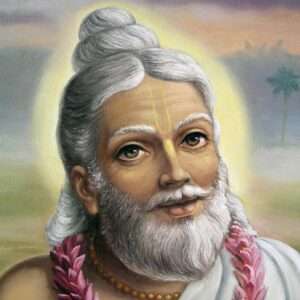Advaita’s appearance
Advaita Acarya appeared as the son of the Varendra Brahmin Kubera Pandita and his wife Nabha Devi in the village of Navagrama near the town of Sylhet on the seventh day of the waxing moon in the month of Magha. Kubera Pandita is identified in the Gaura-ganoddesha-dipika with Mahadeva’s friend and the leader of Guhyakas, Kuvera, the Deva of wealth.
Kubera Pandita, a devotee of Nrisingha, resided in the village of Navagrama near Sylhet in Bangladesh. He was a greatly fortunate follower of the path of devotion; he knew nothing other than the lotus feet of Krishna. His devoted and faithful wife was named Nabha Devi. She is worshipable to the whole world for she is the mother of Advaita Prabhu.
On the seventh day of the waxing moon in the month of Magha, the great ocean of joy overflowed. In that auspicious moment, the moon of Advaita descended in the blessed womb of Nabha Devi. In his ecstasy, Kubera Pandita gave in charity to the Brahmins and the poor. He tiptoed to the birthing room and his heart was filled with gladness upon seeing his son’s face. All the villagers came running to his house and said to each other, “What pious works did this Brahmin do that in his old age he has been blessed with such a jewel of a son?” The gods rained down flowers without being seen. There is nothing with which this scene can compare. Ghanashyama sings of this great auspicious occasion when a joyous uproar rang around the earth.
In the Gaudiya Vaishnava Abhidhana, Laura Gram is said to be Advaita’s birthplace and that Advaita Prabhu left Laura Gram to go to live in Sylhet before moving to to Shantipur. He also had a home in Nabadwip, where he was known as Sri Kamalaksha or Kamala Kanta Vedapanchanana. His birth was in 1434 AD, and he disappeared at the age of 125 in the year 1559.
However, Jahnava Mata’s diksha disciple Nityananda Das wrote in his Prema-vilasa that Advaita’s birthplace was actually in Shantipur. He writes that Advaita earned the title Acarya from the scholar ShantAcarya, who lived in the Phullabati section of Shantipur, with whom he studied the Vedas and other scriptures. Advaita’s life has been described in several Bengali books, including Advaita-mangala, Advaita-vilasa and Sitacaritra. In the Advaita-vilasa it is written, “The lord remained on this earth for a century and a quarter, performing unlimited pastimes.”
This is a section of the book “On a Silver Platter”.
To buy the complete book, click here




Leave a Reply